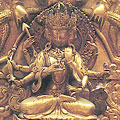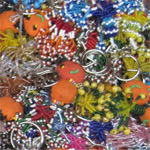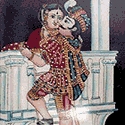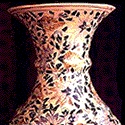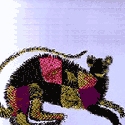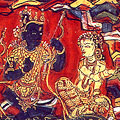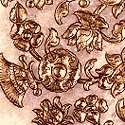An all-enveloping, hooded blanket (ghum rari/ boku) is worn for protection against wind and rain. It is, in fact, a blanket folded into half and stitched up along one half at the selvedge. The hood so formed hangs down at the back over the seam, while the un-stitched sides hand down in the front, giving the appearance of a cloak - in cold weather the hood is worn over the head.
Ornaments and necklaces made of fine strips of cane and grass are popular with the hill tribes in the area. The indigenous jewellery made from forest-based products involves very intricate work and is exceptionally beautiful. The Akas make bamboo bangles and ear ornaments which they decorate with intricate burnt-poker work designs. Besides making ear ornaments from glass beads, wild seeds, cane, bamboo, and reed the Wanchos make beautiful necklaces out of grass.
Popularly known as moti bharat, the bead work of Saurashtra is a ritual oriented craft and plays an important role in the life of women. Indhonis, mangal kalash, and nariyal, torans, made of multicoloured beads are essential in every Gujarati marriage ceremony and in every Gujarati home. Threaded together by tribal women during their leisure hours, colorful beadwork is widely used in the tribal belt due to its affordability in the face of silver and its distinct character. Although beads cast in terracotta date back to the Indus Valley Civilization, beadwork in Gujarat came into its own in urban culture with the advent of European colonization. Terracotta, glass, stone, metal and even plastic forms the raw elements from which beads are produced. Beadwork has permeated into other craft forms, such as embroidery, enhancing their appeal.
Tribals are extremely fond of jewellery and ornaments. Coloured beads are often strung together as simple necklaces and worn around the neck. Others make the beads into attractive patterns. The Wanchos make ear ornaments from glass beads, wild seeds, cane, bamboo, and reed. In southeast Arunachal Pradesh beads of agate stone, brass, and silver are also used.
Ferozabad in Uttar Pradesh is synonymous with glass as the entire community is involved with this craft. Traditionally this town produced only glass bangles but presently glass table ware and other sophisticated products are produced. Varanasi is known for its glass beads and a very thin glass from which little pieces locally called tikulis are cut. These adorn the foreheads of women or are used for decorating fabrics, while glass mouthpieces for hukkas and toys containing coloured liquid called panchkora are the specialities of Saharanpur. Varanasi is one of India’s largest exporters of beads and bead products. Different types of beads are used to ornament various products like clothing, decorative items, curtains, purses, clothing accessories, jewellery and suchlike, and this trend is increasing rapidly. More than 2,000 artisans are involved in bead production and handicrafts in Varanasi, with most of them being concentrated in the areas of Chandpur, Kandwan and Ramnagar. Glass, the major raw material required, is getting expensive and scarce. Better training and technology are also needed to scale up this growing industry, since it has great potential. Major products include earrings, bracelets and neckpieces made out of multicoloured glass beads.
The technique of painting on glass in India originated in the second half of the 18th century, chiefly owing to the influence of Chinese artists who lived and worked for the nobility and royalty. Glass paintings, as the name indicates, are paintings done on clear glass. The process requires immense skill and, as a genre, glass painting is extremely difficult for the sequence of steps followed when painting on an opaque surface, is reversed in painting glass. Although religious themes dominate, court scenes and portraits are also common. Essentially a popular art, the technique of glass painting spread rapidly in western and southern India, though examples of regional styles are also found in Uttar Pradesh, Rajasthan, Bihar, and Bengal. The town of Thanjavur ( Tamil Nadu) became known for the craft of painting on glass and this tradition continues till today. Very often the glass paintings are mistakenly referred to as the Thanjavur sacred icon paintings since these glass paintings tend to repeat the composition of their more expensive counterpart. The glass paintings are decorated with gold leaf, thereby providing devotional images for the puja (worship) room. The colours used are rich and bold and have a feeling of opulence. If the figure painted is that of a deity it is surrounded or housed within a frame. Often the formal frame is created by depicting heavily fringed and tasselled curtains, chandeliers, glass lamps, winged angels, or heavy furniture. Painting on glass involves a process different from the procedure used when painting on opaque surfaces. The technique requires visual memory since the details, especially the finishing and shading lines, are painted in first and the large areas of colour are filled in afterwards. The picture is mounted with its unpainted side uppermost so that it can be viewed through the glass. The paintings are executed by skilled artists who wield a bold and confident brush. The picture, in tempera, is begun with the brush outlines and finer details being filled in first. Interestingly when the painting is finished these lines appear on the top layer. When areas were left unpainted a gold or silver foil is pasted on to give the effect of gilding. The next stage is when the larger areas are filled in with opaque paints. These areas are generally given a flat finish except when depicting drapery or when used to depict the face and body, in which case shading techniques are used.
Southern India has its own distinctive glazed pottery. Vellore in North Arcot district has a tradition of black and red pottery. Usilampatti in Madurai district has black pottery painted over with yellow. Panruti in South Arcot district is famous for its clay figures of deities and toys. Karigiri also in South Arcot district is famous for its glazed pottery (which uses china clay called namakette decorated with patterns and dish trays), flower vases, decorative animal and bird figures, paperweights and tableware. At Auroville in Pondichery a heavy kiln-dried pottery is crafted. This pottery resembling stoneware, and is finished with a variety of glazes. Constant experimentation and development has been the hallmark of this center. Contemporary tableware and household utility items are some of the products crafted here.
Southern India has its own distinctive glazed pottery. Vellore in North Arcot district has a tradition of black and red pottery. Usilampatti in Madurai district has black pottery painted over with yellow. Panruti in South Arcot district is famous for its clay figures of deities and toys. Karigiri also in South Arcot district is famous for its glazed pottery (which uses china clay called namakette decorated with patterns and dish trays), flower vases, decorative animal and bird figures, paperweights and tableware.
This kind of pottery falls under the glazed pottery category. The colours are shades of blue and brown with which designs are done on white or cream surfaces. The products made include cups, saucers, bowls and vases. The designs are mainly geometric. Khurja in Uttar Pradesh is famous for ceramic pottery. The pottery, done with relief work, uses earth colours like orange, brown, and terracotta, worked on to a white background. The products made include decorative items and table ware.
The glove puppet which may also be referred to as hand puppets is characterised by a small figure with a head and arms, and a long skirt as part of its costume. The puppeteers fit their index finger into the hollow head of the puppet; and the middle finger and the thumb into the two hollow hands of the puppet, hence the name glove puppet. Commonly nomads would put up performances in open spaces using these puppets and minimum props. These people usually belong to the lower strata of the society. This craft is a mean for them to earn a livelihood and sustain themselves. As they belong to the lower strata of the society, they didn't have the necessary means to chronicle this craft. In the southern region of West Bengal, glove puppets are popularly referred to as Bener Putul, meaning dolls of the commercial people. Typically the puppeteers come from the scheduled caste of the old palanquin-bearers, commonly from among the land-less labour. The puppets are one and a half foot tall, and have terracotta heads and wooden arms. The puppets have anklets fixed on their arms, which help in keeping rhythm by clapping. The puppeteers attract the attention of the crowd with the help of a Domru (small drums) and sing songs during the show to tell the story. The music is inspired by either common folk tunes or even popular Hindi or Bengali songs, complete with hearty humour and sarcasm. The puppeteers through their craft tell tales of social events like linguistic differences, escapades of people in love, or even family planning.
For the Bengali people, arts and crafts holds a special place. Then it's no surprise to find this passion to be visible in their food also. Gohona Bori of West Bengal is a fine example of this. For the people of Bengali origin, the bori signifies small pieces of spiced or unspiced sun dried, urad dal (black gram lentil) paste which are fried and eaten. While the Gohona or the more vernacular Goyna refers to jewellery. These Gohona Bori's are popular among the eminent personalities of Bengali literature like Abanindranath Tagore, Rabindranath Tagore, Bankimchandra, Nandalal Bose etc; and have earned high praises in their literary pieces.
Traditionally, the parents give boris to the bride to take along with her when she goes to her marital home. It becomes a measure of their status. Boris's have also found place in children's rhymes. The poor man's staple food, the urad dal or kolai or beuli dal is the most affordable pulse available while having the highest nutritional content. Hence it has been given an important place in major festivals and everyday rituals. Dried opium seeds or posto is another important ingredient in the recipe. In an attempt to prevent the bori's from sticking to the surface and infuse flavour, boris are created on a spread of these seeds. However as this ingredient is not characteristic of the area and is expensive, it may be substituted with sesame seeds. As the urad dal can be found in abundance in East Medinipur, it has become synonymous with the centre for innovation of this skilled art form. Rather than having religious or traditional connotations the craft is practiced by ladies as a fundamental part of housewife's winter household routine. The women make Gohona Bori's as a community, where everyone from the masters, fluent in the craft to the newcomers being introduced to the craft takes part in a hierarchical manner.
The art form has spread out from Medinipur, as brides from here have gone to different parts of Bengal and have taken these skills with them. The modern day women are trying to introduce new elements and designs into the traditional by utilising their knowledge of intricate Alpana patterns. While bori's are made in a variety of ways with different types of lentils and seasonings, the simpler bori's are the most popular and can easily be found in most Bengali households. However the Gohona Bori is a fast disappearing village craft. Commercially producing boris as a financially possible marketable product isn't a viable option. As quality control is an important aspect in the production and the sale of these Gohona Bori's. Apart from this packaging these delicacies for exporting is a challenge in itself. All these apprehensions kept aside, if the bori's were to gain popularity in foreign markets, the domestic industry has the fear of being replaced by replicas.
In the past few years, this unique edible decorative art has played an important role in empowering women local women of the area and helped it grow from a household industry to a cottage industry. Efforts have been made by local administrations and some self help groups to restore this art form.
This extremely labour intensive craft where silver and gold are beaten continuously for hours to achieve the unbelievably thin foil is a speciality of Lucknow and Varanasi in Uttar Pradesh. A 10 gram piece of metal is placed between deerskin leaves(farma) and is pounded for 4 hours non-stop to get 180 pieces of varaq. Gold is beaten for 12 hours. Tools such as leather booklet/farma or daftar, stone slab/kasauti ka pathar, blunt blade/phalua, bamboo tweezer/cheep/chimti, wooden board/phatta are used during the crafting process.
The 500-year old Buddhist text Pragyanparamita, illuminated with gold and silver writing, is a marvellous sight even today as the passage of time has not affected either the paper or the text. The process of preparing these gold and silver inks is a closely guarded secret that is handed down from father to son; in fact the technique of preparing the gold powder tablet (cholun) - one of the critical ingredients - is also a closely guarded secret. It is said that the original formula was brought to Nepal in secret from Tibet. This gold powder tablet is more expensive than its equivalent weight in gold. Both gold and silver powder are used to write on black (or dark) neel patra paper.
The traditional jewellery of Sri Lanka represents ornate and stylised work, chiefly in gold and silver. The gold and silver artisans are organised in caste-based artisanal 'guilds', and represent a family tradition that has thrived on the patronage of royalty and the wealthy. Foreign occupation of Sri Lanka and the decline of royal rule did affect jewellery-making, which was a highly traditional skill, closely related to royal patronage. However, the tradition survived and continues, owing to the combination of adornment, wealth, and investment that gold and silver jewellery represent in Sri Lanka. The beneficial effects that certain metals and gems are supposed to confer on the wearer has also been important in the continuity of the tradition of crafting jewellery. Although the craft is present in almost all parts of the country, yet Kandyan gold and silver jewellery is especially well-known. There is supposed to have been much engagement between Kandyan jewellery stylisation and that of south India, chiefly due to inter-marriage between Kandyan kings and south Indian women, and a steady stream of Indian goldsmiths to Sri Lanka. Aside from this, some European influence, chiefly in the context of imperial-colonial interaction is visible. At the Sri Lanka National Design Centre a lot of innovations in designs are being done for jewellery especially with foreign collaboration. Due to the recent awareness about the importance of preservation of ecology, jewellery is being made with natural raw materials like wood, raffia, shells, leather, fibre, stone and even coconut shells.
...and then on the day of the full moon the king adorned himself with all the grace of a god, with a diadem and a chain of gold and bracelets and precious ornaments of such kind thickly set with diverse gems. And many hundred women of the queen's chamber, whose forms beautifully attired, were like those of goddesses for elegance, accompanied him, and many chieftains also, of great fame, clothed with divers robes and jewels and glittering ornaments. And the earth sunk, as it were, with the weight of this great multitude, and of the troops of horses and elephants in their trappings of shining gold, and of the worshippers who honoured the Cetiya with offerings of lamps which they carried on their bodies. And every quarter thereof was covered, as it were, with parasols and banners and chowries; and the caverns seemed to burst asunder with the sounds of divers instruments of music; and the eyes of all the people were filled with tears of joy by reason of the exceeding great beauty of the sight; and the caskets and flags and vases and fans and pots and other utensils of gold sent forth rays which made all the place to seem yellow.From the Sinhalese treatise Mahavamsa (Chapter LXXVI.), cited in Ananda K Coomaraswamy, Mediaeval Sinhalese Art (1956, Pantheon Books, New York) In the time of kingly rule in Sri Lanka, guilds of master craftsmen, the pattal hatara, were appointed by royalty for purposes of making jewellery. Each jewellery workshop usually had a mulachari or chief-craftsman, under whom other craftspersons worked. The feudal system allowed royalty exclusive access to the services of these craftsmen; their craft was essentially classified into four categories: the making of (a) ornaments or abharana (b) crowns or otunus (c) swords or rankadus (d) thrones or simhasanas. Craftsmen in different guilds or workshops competed with each other to create original pieces of work, the avenue to improved socio-economic status and recognition. Traditional ornaments for royalty included the very elaborate siv sata abharana or 64 ornaments. Several villages in the Kandyan district acquired distinction in making crowns, tiaras, head ornaments, frontlets, forehead plates, girdles, armlets, bangles, necklaces, ear-rings, rings, anklets and foot ornaments for the king. Several links exist between royal patronage and the jewellery craft. King Vikrama Bahu of the Hill Country region (Kandy) is supposed to have ordered master-craftsmen to make the regalia for his coronation; he then gifted the villages of Ayagama and Yatatnava to the makers of the crown, Godagama and Amunugama to the makers of the ran kaduwa or the golden sword, and the villages of Walwasagoda and Krukuttala to the makers of the nalalpeta or frontlet. A gold mounted sandalwood paste cup known as the pacca-kusalana - set with rubies and sapphires - is said to have been dedicated by the King Rajadhi Raja Simha with the charter of verses of the Jaya Saka and Algama Sannasa after a victory over the Dutch at Gurubebile. This was subsequently used at all royal inauguration ceremonies, when the sword of the state was first girded on the new king. The gold writing style or pen, panhinda, bearing the royal 'SRI' that was given by King Narendra Simha of Kandy to Dehigama - who held the office of mahagabada nilame (Second Treasurer) and was also the diva nilame or the Chief Custodian of the Temple of the Tooth Relic at Kandy - is another beautiful piece of crafted gold. The link between royalty and gold and silver work was closely established by the royal sign of 'SRI', the insignia on grants and charters. This was usually inlaid in gold within a plain space, with an embossed fluted gold frame raised upon the surface of the plate. One of those recovered (dated AD 1736) is held to be the last charter or sannasa of a Kandyan king. Another fine sannasa is the Getabriya Sannasa of AD 1760. This is on a copper plate, with ornamental silver framing, and the royal insignia inlaid in gold, embellished with the sun and moon, 16 stars, and 14 flower ornaments.
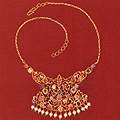
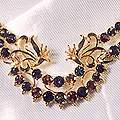
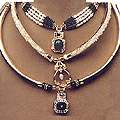
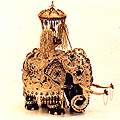
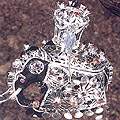
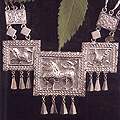
This art came to India with Usta artists from Iran brought here by the emperors. It flourished in the Mughal period in courts and palaces. In the time of Akbar, a group of seven Usta artists came to Bikaner. The craftsmanship and skill of these famous artists can be seen even today in the rooms of the Junagarh fort. After the required design is made, powdered pitcher clay is used for embossing. After this, it is painted and gold is applied where required. After this ink is applied with a brush made of squirrel hair and different colours are filled into the design.
In the early morning light the first rays of the sun strike and illuminate the gilded temples of Nepal. The skilled craft of gilding dates back more than a thousand years - ancient temples bear evidence to this. The gilded figures of Acharya Bandhu Dutta, King Narendra Deva, and the former Ratham Chakra of Lalitpur - all kept preserved in the temple of Sri Machhindra Nath - are more than a thousand years old, according to a Vamshavali chronicle. The craft of gilding is still practised and metal icons of the gods and goddesses continue to be embellished with gold. Gilding can be done on silver, copper, and high grade brass (80 per cent copper and 20 per cent zinc, as this proportion results in a gold coating that is long lasting, while gold coating is easily destroyed on a surface of copper mixed with lead).
